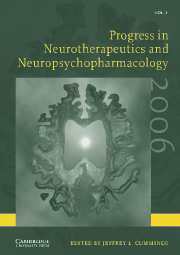Book contents
- Frontmatter
- Contents
- Preface
- Contributors
- Introduction to neurotherapeutics and neuropsychopharmacology
- Rivastigmine in the treatment of dementia associated with Parkinson's disease: a randomized, double-blind, placebo-controlled study
- Modafinil for the treatment of fatigue in multiple sclerosis
- Radiotherapy with concurrent and adjuvant temozolomide: a new standard of care for glioblastoma multiforme
- Treating migraine attacks ASAP: concept and methodological issues
- Early phase trials of minocycline in amyotrophic lateral sclerosis
- Creatine as a potential treatment for amyotrophic lateral sclerosis
- AVP-923 as a novel treatment for pseudobulbar affect in ALS
- Liquid fluoxetine versus placebo for repetitive behaviors in childhood autism
- Testing multiple novel mechanisms for treating schizophrenia in a single trial
- Selegiline in the treatment of negative symptoms of schizophrenia
- Analysis of the cognitive enhancing effects of modafinil in schizophrenia
- Efficacy and tolerability of ziprasidone and olanzapine in acutely ill inpatients with schizophrenia or schizoaffective disorder: results of a double-blind, six-week study, with a six-month, double-blind, continuation phase
- Subject index
- Author index
Selegiline in the treatment of negative symptoms of schizophrenia
Published online by Cambridge University Press: 22 March 2010
- Frontmatter
- Contents
- Preface
- Contributors
- Introduction to neurotherapeutics and neuropsychopharmacology
- Rivastigmine in the treatment of dementia associated with Parkinson's disease: a randomized, double-blind, placebo-controlled study
- Modafinil for the treatment of fatigue in multiple sclerosis
- Radiotherapy with concurrent and adjuvant temozolomide: a new standard of care for glioblastoma multiforme
- Treating migraine attacks ASAP: concept and methodological issues
- Early phase trials of minocycline in amyotrophic lateral sclerosis
- Creatine as a potential treatment for amyotrophic lateral sclerosis
- AVP-923 as a novel treatment for pseudobulbar affect in ALS
- Liquid fluoxetine versus placebo for repetitive behaviors in childhood autism
- Testing multiple novel mechanisms for treating schizophrenia in a single trial
- Selegiline in the treatment of negative symptoms of schizophrenia
- Analysis of the cognitive enhancing effects of modafinil in schizophrenia
- Efficacy and tolerability of ziprasidone and olanzapine in acutely ill inpatients with schizophrenia or schizoaffective disorder: results of a double-blind, six-week study, with a six-month, double-blind, continuation phase
- Subject index
- Author index
Summary
Key words: Selegiline; schizophrenia; negative symptoms; neurotherapeutics; clinical trial.
Introduction and Overview
One of the great successes of modern psychiatry was the introduction of antipsychotic drugs over 50 years ago (Ayd & Blackwell, 1970). The impressive effectiveness of these agents in relieving florid positive symptoms of schizophrenia has permitted a whole population of formerly institutionalized patients to live in the community. Unfortunately, this great benefit has not been matched by the effect of antipsychotic drugs on the negative symptoms of schizophrenia, which so limit the daily function of these patients, and classical neuroleptics often worsened these symptoms. More recently, atypical antipsychotics have shown improved properties in this regard, but negative symptoms remain the least medication-responsive features of chronic schizophrenia.
The impoverishment of emotion and initiative that underlie negative symptoms resemble symptoms affecting patients with Parkinson's disease, as well as the pseudo-parkinsonian effects of first-generation antipsychotics, and has been hypothesized to reflect specific deficits in the functioning of dopaminergic pathways (Bermanzohn & Siris, 1992; Davis et al., 1991). Selegiline (formerly 1-depreny1) is a dopamine enhancing antiparkinsonian drug (Knoll, 1983), which acts as a selective monoamine oxidase type B (MAO-B) inhibitor without the clinical toxicities that have limited the use of non-selective MAO inhibitors (MAOIs) in psychiatry. The potential of selegiline to alleviate some of the parkinsonian-like emotional deficits of schizo-phrenics has led to a series of investigations of its use as a specific remedy for negative symptoms over the past 15 years.
- Type
- Chapter
- Information
- Progress in Neurotherapeutics and Neuropsychopharmacology , pp. 121 - 132Publisher: Cambridge University PressPrint publication year: 2006
- 1
- Cited by



